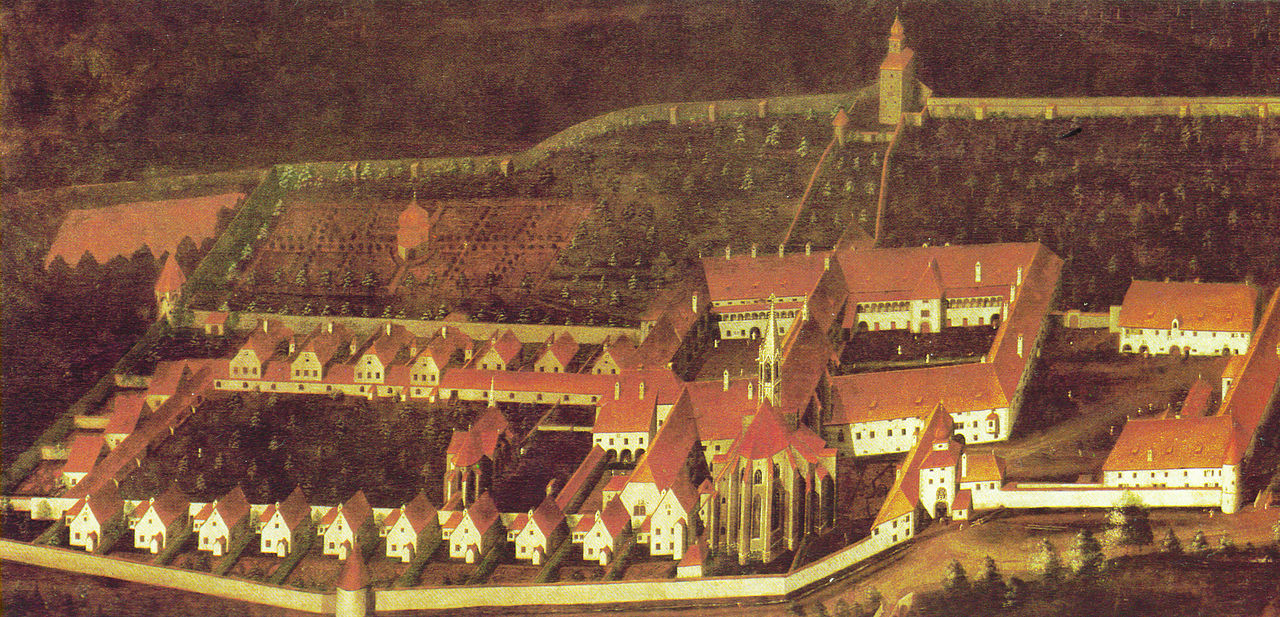.JPG/1024px-Gaming_-_Kartause_(1).JPG) |
| The Gaming Kartause today |
The following is an article about the closing of monasteries under the liberal Joseph II.
In the 1990's I was blessed to visit the beautiful former Carthusian Monastery in Gaming, Austria, closed by the imperial decree in the 1790's. From Eduard Habsburg at
First Things:
Some readers may have never been guests in a contemplative monastery
or convent. Today, genuine contemplation can be hard to find. Several
times in recent months I have had the privilege of being a guest in such
a place. This enclosed and protected environment, with its total
concentration on prayer, sacrifice, spirituality, great simplicity,
purity, and the contagious cheerfulness of the sisters behind their
grilles—all this is infinitely valuable and easily damaged. It is
something that every town, every country should thank God for; the
contemplative life bears the most precious spiritual fruit. It is
something for which, if it were threatened, one would give life and
limb.
We must imagine this kind of life and world—innocent, vulnerable,
full of the most profound trust in state and Church, where everything is
ordered for the sake of prayer and community life—that suddenly was
overtaken by an unprovoked and undeserved apocalypse of destruction,
simply because an emperor decided that it was “useless.”
The storm began to wreak havoc at the beginning of 1782, although it
was brewing in the time of the Empress Maria Theresia, and that of her
father, Charles VI. For decades there had been talk of reforming the
religious houses. At the end of 1781, however, problems had arisen at
the Carthusian house of Mauerbach, and Emperor Joseph II's anger grew.
This is what he wrote on December 6, 1781:
There is longstanding evidence that those Orders that are of
no practical use to their neighbors are not pleasing to God:
accordingly I have commanded the Chancellery to send Commissioners to
list those Orders (of men and of women) in all crown lands that neither
maintain schools nor care for the sick, nor are prominent in other
useful activities: their inmates shall be ejected and given their
liberty. Those who are not so numerous may leave our lands without a
pension, or else they may apply to the local authorities to be dispensed
from their vows... These Orders I understand to include all the
Carthusians, Camaldolese and Hermits, and also all the women Carmelites,
Poor Clares, Capuchin Sisters, and the like, who neither educate the
young nor maintain schools, nor take care of the sick, but, whether men
or women, merely lead a contemplative life.
On January 12, 1782, judgment was served on places of “uselessness.”
One hundred and forty contemplative houses were closed in the first
wave: This meant that around 1,500 religious sisters and brothers had to
leave. Just imagine: All the contemplative monasteries and convents
that could not be turned into schools and hospitals were shut—thereby
putting a definitive end to their “enclosure.” In certain cases, members
of the Orders were settled in other, non-contemplative houses, but in
most cases they were simply “sent home.” Only a small number managed to
make the change into a “life of usefulness.” Joseph II did not stop
here, however. He began closing non-contemplative monasteries and
convents also, with the result that in this first wave (1782–83), 400
religious houses were closed.
In 1782, Pope Pius VI made a fruitless journey to Vienna to discuss
the matter with the emperor. This visit achieved nothing. Dissolutions
continued and even increased. A second wave, beginning in 1783, engulfed
another 800 houses in Austria and the crown lands. In 1791 Emperor
Joseph II had envisaged a third wave of 450 closures; only his death
prevented them from being carried out. In the end, two-thirds of all
religious houses were closed, and not a single contemplative Order was
left. (Read more.)
 |
| The Gaming Charterhouse before its closing |
Share
.JPG/1024px-Gaming_-_Kartause_(1).JPG)


















No comments:
Post a Comment